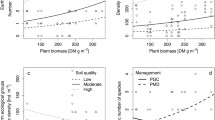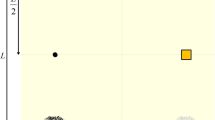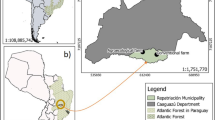Abstract
Earthworms are known to increase soil bulk density, soil porosity, mixing of organic matter, and to strengthen aggregation of soil particles. They perform important functions in the maintenance and stabilization of the soil matrix. Historically, temperate intercropping research has focused on the above-ground benefits of adding trees into the agricultural landscape. Earthworm research in temperate intercropping systems has been non-existent to date. More emphasis on studying below-ground components, such as earthworms, is required in order to better understand the mechanisms of intercropping ecosystem function. The purpose of this study was to examine seasonal changes in distribution and abundance of earthworms under a temperate intercropping system in southwestern Ontario, Canada. Sampling occurred during the spring and summer of 1997 at the University of Guelph's Agroforestry Research Station, Guelph, Ontario. Earthworm samples were collected at various distances from the tree rows. Significant variation in both earthworm biomass and density were found between the three tree species sampled. Total mean earthworm density was 182 m-2 within the poplar rows, 71 m-2 within the silver maple rows, and 90 m-2 within the white ash rows. A marked difference was also observed in the distribution of earthworms within the tree rows and the field area. For example, total mean density within the tree rows for poplar was 182 individuals m-2, as compared to total mean densities of 117 and 95 individuals m-2, two metres and six metres into the field from the tree, respectively.
Similar content being viewed by others
References
De St. Remy EA and Daynard TB (1982) Effects of tillage methods on earthworm populations in monoculture corn. Canadian Journal of Soil Science 62: 699–703
Doube BM, Buckerfield JC and Kirkegaard JA (1994) Short-term effects of tillage and stubble management on earthworm populations in cropping systems in southern New South Wales. Australian Journal of Agricultural Research 45: 1587–1600
Edwards CA and Lofty JR (1977) Biology of Earthworms. Chapman and Hall, London
Edwards CA and Bohlen PJ (1997) Biology and Ecology of Earthworms, pp 55–180. Chapman and Hall, London
Hauser S (1993) Distribution and activity of earthworms and contribution to nutrient recycling in alley cropping. Biology and Fertility of Soils 15: 16–20
Kang BT, Akinnifesi FK and Pleysier JL (1994) Effect of agroforestry woody species on earthworm activity and physicochemical properties of worm casts. Biology and Fertility of Soils 18: 193–199
Kimmins JP (1997) Forest Ecology. MacMillan Publishing Co, New York, 596 pp
Lavelle P (1988) Earthworm activities and the soil system. Biology and Fertility of Soils 6: 237–251
Lee KE (1985) Earthworms: Their Ecology and Relationships with Soils and Land Use. Academic Press, New York
Nair PKR (ed) (1989) Agroforestry Systems in the Tropics. Kluwer Academic Publishers, The Netherlands
Ong CK and Huxley P (eds) (1996) Tree–Crop Interactions. CAB International, Wallingford, UK
Park J, Newman SW and Cousins SH (1994) The effects of poplar (P. trichocarpa x deltoides) on soil biological properties in a silvoarable system. Agroforestry Systems 25: 111–118
Rhoades CC (1997) Single-tree influences on soil properties in agroforestry: lessons from natural forest and savanna ecosystems. Agroforestry Systems 35: 71–94
SAS version 6.04 (1989) SAS Institute Inc
Springett JO and Gray R (1997) The interaction between plant roots and earthworm burrows in pasture. Soil Biology and Biochemistry 29(3/4): 621–625
Thevathasan N and Gordon AM (1997) Poplar leaf biomass distribution and nitrogen dynamics in a poplar–barley intercropped system in southern Ontario, Canada. Agroforestry Systems 37: 79–90
Tian G (1992) Biological Effects of Plant Residues with Contrasting Chemical Composition on Plant and Soil under Humid Tropical Conditions, pp 69–86. Kluwer Academic Press, Wageningen
Tomlin AD, McCabe D and Protz R (1992) Species composition and seasonal variation of earthworms and their effect on soil properties in Southern Ontario, Canada. Soil Biology and Biochemistry 24(12): 1451–1457
Tomlin AD, Tu CM and Miller JJ (1995). Response of earthworms and soil biota to agricultural practices in corn, soybean, and cereal rotations. Acta Zool Fenn 196: 195–199
Willems JJ, Marinissen JC and Blair J (1996) Effects of earthworms on nitrogen mineralization. Biology and Fertility of Soils 23: 57–63
Williams PA and Gordon AM (1992) Potential of intercropping as an alternative land use system in temperate North America. Agroforestry Systems 19: 253–263
Author information
Authors and Affiliations
Corresponding author
Rights and permissions
About this article
Cite this article
Price, G.W., Gordon, A.M. Spatial and temporal distribution of earthworms in a temperate intercropping system in southern Ontario, Canada. Agroforestry Systems 44, 141–149 (1998). https://doi.org/10.1023/A:1006213603150
Issue Date:
DOI: https://doi.org/10.1023/A:1006213603150




